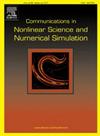Computation of fixed points in MAX and MIN multi-state networks
IF 3.4
2区 数学
Q1 MATHEMATICS, APPLIED
Communications in Nonlinear Science and Numerical Simulation
Pub Date : 2025-02-14
DOI:10.1016/j.cnsns.2025.108672
引用次数: 0
Abstract
In this work, we study the fixed points of multi-state networks over a complement-closed set , a wide generalization of Boolean networks and some types of multi-state networks. We particularly focus on MAX (and MIN) multi-state networks, whose corresponding graph is undirected and all self-loop, and where the global evolution operator is induced by a disjunction (or conjunction) of direct and complemented variables, independently of the updating scheme (synchronous, asynchronous or mixed). In this context, we characterize the exact configurations of fixed points and provide the best possible lower and upper bounds for their number analytically. As a corollary, we prove that a Fixed Point Theorem is not possible for non-binary MAX (and MIN) multi-state networks, i.e., when .
求助全文
约1分钟内获得全文
求助全文
来源期刊

Communications in Nonlinear Science and Numerical Simulation
MATHEMATICS, APPLIED-MATHEMATICS, INTERDISCIPLINARY APPLICATIONS
CiteScore
6.80
自引率
7.70%
发文量
378
审稿时长
78 days
期刊介绍:
The journal publishes original research findings on experimental observation, mathematical modeling, theoretical analysis and numerical simulation, for more accurate description, better prediction or novel application, of nonlinear phenomena in science and engineering. It offers a venue for researchers to make rapid exchange of ideas and techniques in nonlinear science and complexity.
The submission of manuscripts with cross-disciplinary approaches in nonlinear science and complexity is particularly encouraged.
Topics of interest:
Nonlinear differential or delay equations, Lie group analysis and asymptotic methods, Discontinuous systems, Fractals, Fractional calculus and dynamics, Nonlinear effects in quantum mechanics, Nonlinear stochastic processes, Experimental nonlinear science, Time-series and signal analysis, Computational methods and simulations in nonlinear science and engineering, Control of dynamical systems, Synchronization, Lyapunov analysis, High-dimensional chaos and turbulence, Chaos in Hamiltonian systems, Integrable systems and solitons, Collective behavior in many-body systems, Biological physics and networks, Nonlinear mechanical systems, Complex systems and complexity.
No length limitation for contributions is set, but only concisely written manuscripts are published. Brief papers are published on the basis of Rapid Communications. Discussions of previously published papers are welcome.
 求助内容:
求助内容: 应助结果提醒方式:
应助结果提醒方式:


